mobile View, to the German Version tap the flag


Pirates existed at all times on the seas. In the times in which flags were not yet modern on ships, in antiquity and the early middle ages, the pirates sailed undetected and used the element of surprise. Later, when ships used flags, they had to tell who they really are. Initially they came closer under a "false flag", then, in the moment of attack, the famous pirate flags were hoisted. There were actually no specific identification marks, which always could be associated with a special pirate – such flags existed too – but they were signs of deterrence, also called blood flags. A remnant from the old times, in which , for example, the besieged signaled the besiegers with a red flag that they will fight up to the last and not going to give up, what should point out to certain bloodshed. At sea this kind of deterrence should make clear the serious situation to the harassed, but also bring about a quick surrender. Insofar pirate flags were initially red, later black. Some flags, but not all, showed skulls, bones or skeletons sometimes added by swords or even hourglasses ("Your time is running out"). Today the black pirate flag is generally called as "Jolly Roger", but this is nothing more than an English spoonerism of the French words "Joli Rouge" what means "pretty red", and thus points out to the original red pirate flags. In the beginning of the 18th century the piracy declined increasingly, not only because the world getting smaller and unoccupied nooks became lesser and lesser, but mainly because there was a legal possibility of robbery at sea by the letters of marque. Letters of marque were means of warfare that individuals allowed to attack and rob merchantmen of the enemy nation, but a share of the spoils they had to give to the maker of the letter of marque. Also in privateering was used the method of the "false flag" to come closer to the enemy. But, when the fire was opened, they had to take down the wrong flag and to hoist their own. This applies in the law of war until today. The modern piracy operates with automatic weapons, speedboats, night vision goggles and satellite navigation, often at night, but flags play no role. Another important red flag – that could be associated with the flags of the pirates somehow – was the quarantine flag. A monochrome red flag that points out to the possibly of infectious diseases on board, which should scare clearly. To distinguish the quarantine flag better from the pirates flags it received a dovetail. In the international signal flag alphabet this flag became the signal flag Bravo ("B"), which signals "danger" until today.
Source: Jürgen Kaltschmitt,
Volker Preuss,
Wikipedia (D),
Book: "Piraten", Heinz Neukirchen, 1982, VEB Transpress Verlag

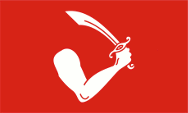
typical red pirate flag



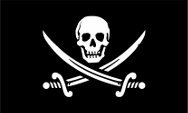
typical black pirate flag



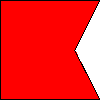
Signal flag B




There have been some pirate celebrities who have made their presence felt with their own flag:

The flag of the pirates Misson and Caraccioli



These would be, for example, the pirates Misson and Caraccioli, who were active around 1690. They were notable for the fact that they were not out to enrich themselves, but lived out their existence in a kind of floating republic of freedom fighters. They and their crew captured only what they needed to live, and foundet finally the Republic of Liberta in northern Madagascar, which lasted a few years before falling victim to an attack by local natives. All of them perished. They rejected the black flag, preferring a white cloth with the golden inscription "For God and Freedom".
Source: Book: "Piraten", Heinz Neukirchen, 1982, VEB Transpress Verlag,
www.msn.com,
Volker Preuss

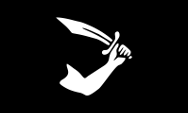
Flag of the pirate Thomas Tew



The pirate Thomas Tew, was only active for a very short time, around 1693. He made only two major voyages and was killed on the last one. He succeeded in capturing the enormous sum of - converted today - 112,2 million euros. He is said to have a black flag with an arm holding a kind of oriental scimitar. That could fit, his stomping ground was the Indian Ocean.
Source:
www.msn.com,
Volker Preuss

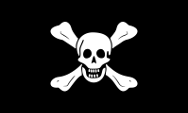
Flag of the pirate John Rackham



John Rackham was a pirate in the Northern Caribbean, Bahamas and Cuba between 1718 and 1720. He was also called "Calico Jack", and before he ended up on the rope for piracy, he brought home a booty of - converted today - 1,6 million euros. He is said to have invented the black pirate flag with the skull and crossbones. That may be doubted.
Source:
www.msn.com,
Volker Preuss

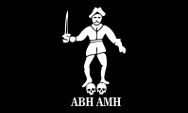
Flag of the pirate Bartholomew Roberts



Bartholomew Roberts was a pirate off America and West Africa between 1719 and 1722. He was called "Black Bart" or "Barti Ddu" in Welsh. Before he fell in battle, he had looted - converted today - 35,1 million euros in booty. His black flag showed a sabre-bearing pirate standing on two skulls. The letters of the acronym "ABH AMH", which meant "A Barbadian's Head, a Martinician's Head", were striking. This probably meant the two skulls on the flag and their origin from Barbados and Martinique.
Source: www.msn.com,
Volker Preuss

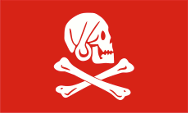
Flag of the pirate Henry Every



Henry Every (1659-ca.1700, aka John Avery, aka Long Ben, aka Benjamin Bridgeman, aka "The Arch Pirate" was another English pirate. His bases were in New England on the East Coast and his hunting ground was the Indian Ocean, where he also operated with Thomas Tew. He specialised in Muslim pilgrim ships and scored a very big coup when he managed to capture the "Gang-I-Sawai", a ship belonging to the family of the Great Mogul of India. The booty alone amounted to 180.000 pounds in money and valuables. The ensuing diplomatic quarrels between the Great Mogul, the English East India Company and the British Crown brought him down. As a kind of "persona non grata", he could no longer frequent his bases unmolested, the pirate troop disbanded and was gradually arrested and executed. Every himself was probably able to escape unmolested. The flag attributed to him showed a skull from the side, with headband and earring and crossed bones below. The flag is described in the colour red, but there are also illustrations showing that motif on a black flag.
Source: Book: "Piraten", Heinz Neukirchen, 1982, VEB Transpress Verlag,
www.welt.de,
Volker Preuss

![]()
























